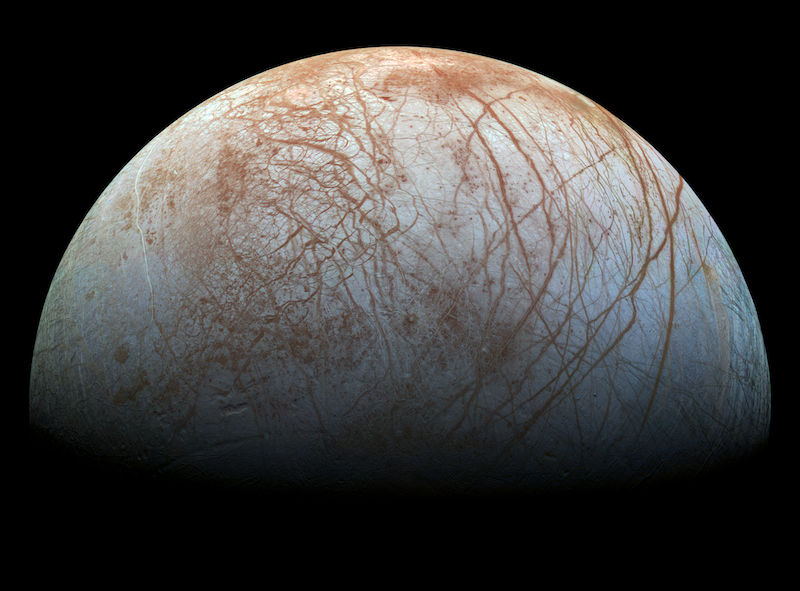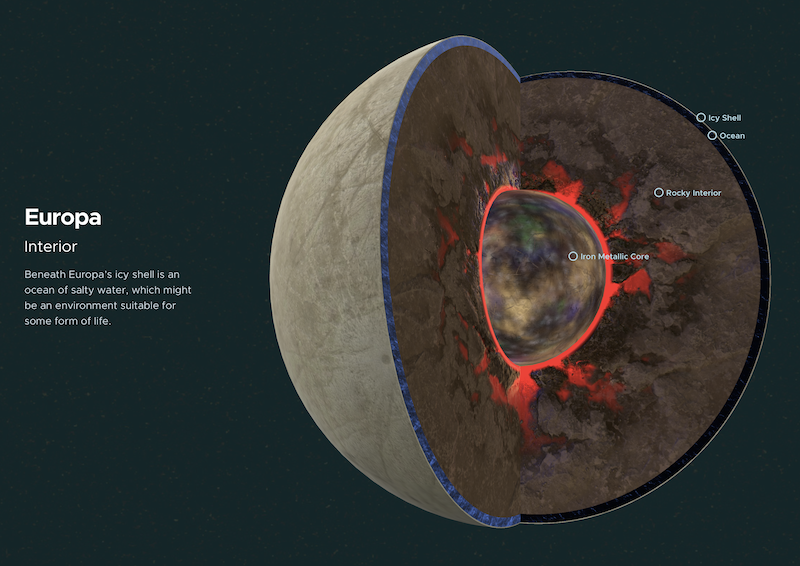
Jupiter’s moon Europa is the best-known of the ocean moons in the outer solar system. A very deep global ocean lies beneath its outer frozen ice crust. However, that ice crust has puzzled scientists. Why? Because it rotates at a different speed than the interior of Europa. On March 13, 2023, researchers at NASA’s Jet Propulsion Laboratory and the University of Oxford in the U.K. said they may have figured out the mystery. Their new study suggests that currents at the top of the ocean push the ice crust above them, so that Europa’s crust “rides” on warm ocean currents.
The journal JGR Planets first published the new peer-reviewed findings on February 19, 2023.
Last chance to get a moon phase calendar! Only a few left. On sale now.
The puzzle of Europa’s icy crust
Scientists already knew that Europa’s crust was likely free-floating, sitting on top of the ocean below. It’s not physically attached to the ocean floor at all, so it’s able to rotate separately from the ocean and rocky mantle deeper below. But that fact alone didn’t seem to fully explain why the crust rotates at a significantly different speed.
The new study helps to better explain just how the crust rotates at a different rate. The results suggest that ocean currents help to push the crust around. This is the first study to find strong evidence for that process. Basically, the ocean exerts a drag force and torque on the ice crust above it. This could help speed up – or slow down – the ice crust’s rotation.
Lead author Hamish Hay, previously at the Jet Propulsion Laboratory at the time of this study, and now at Oxford University, said:
Before this, it was known through laboratory experiments and modeling that heating and cooling of Europa’s ocean may drive currents. Now our results highlight a coupling between the ocean and the rotation of the icy shell that was never previously considered.
Ocean currents could explain surface geology
The researchers say that the same ocean currents – and resulting drag and torque on the crust – could explain some of the geological features on Europa’s surface, too. As the ocean currents push and pull at the crust over time, they can stretch and contract the crust. As a result, cracks and ridges, which are everywhere on Europa’s surface, can form. Indeed, this is why people often say that Europa looks like a cracked egg! Co-author Robert Pappalardo at the Jet Propulsion Laboratory said:
To me, it was completely unexpected that what happens in the ocean’s circulation could be enough to affect the icy shell. That was a huge surprise. And the idea that the cracks and ridges we see on Europa’s surface could be tied to the circulation of the ocean below … geologists don’t usually think, ‘Maybe it’s the ocean doing that.’

Heat plays a role in moving Europa’s icy crust
So currents in the ocean can help move the ice crust. But how do those currents form? Unlike Earth’s oceans, Europa’s global ocean is completely hidden beneath the ice crust. The answer lies in how the ocean remains liquid to begin with. Scientists say that internal heat creates the currents. A combination of radioactive decay and tidal heating, aka tidal friction, within the moon’s core heat the water from below. And as we all learned in science class, warm water rises. Therefore, the warmer water rises to the top of the ocean.
Using computer simulations, the researchers found that the water circulation initially moved vertically. But then, Europa’s rotation caused it to start moving horizontally. The resulting currents moved both west-east and east-west. When the currents were fast enough, the resulting force on the ice crust above caused it to speed up or slow down. The amount of heating in the ocean at any given time can increase or decrease the speed. The paper explains:
Europa’s subsurface ocean is heated from below via tidal heating and radioactive decay of the rocky interior, while being cooled from above by its frozen surface. Simulations and laboratory experiments suggest that this results in convection, whereby heat is transported in rising and sinking plumes of warm and cold water. These plumes are influenced by Europa’s rotation and consequently form jets of alternating east-west oceanic currents. At the surface, the flowing ocean exerts friction on the ice, causing it to move.
As Hay noted:
The work could be important in understanding how other ocean worlds’ rotation speeds may have changed over time. And now that we know about the potential coupling of interior oceans with the surfaces of these bodies, we may learn more about their geological histories as well as Europa’s.
Europa Clipper
NASA’s Europa Clipper, set to launch in 2024, will be able to take even better measurements. It should determine just how fast the ice crust rotates with greatly improved accuracy. With this in mind, researchers can compare images of Europa’s surface taken by Clipper with older ones taken by Galileo and Voyager. By looking at specific surface features, the researchers can tell if the crust moved during that time and by how much.
Bottom line: A new study from NASA’s Jet Propulsion Laboratory and Oxford University shows how ocean currents can affect how fast or slow Europa’s icy crust rotates.











